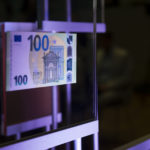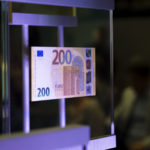The new €100 and €200 banknotes, harder to counterfeit
The European Central Bank unveiled today the new €100 and €200 notes, which will be introduced in May 28, 2019. These notes complete the Europe series, the second since the introduction of the euro. The new notes, featuring security components that make them harder to counterfeit, are the highest-value denominations after the phase out of the €500 note.

Yves Mersch, member of the Governing Council of the European Central Bank, unveiled the new €100 and €200 designs during an event held in Frankfurt. These notes complete the Europa series, launched in 2013. The Europa series is being introduced gradually over several years, in ascending order. The first four notes - €5, €10, €20 and €50 - started circulating in 2013, 2014, 2015 and 2017 respectively. The most recent launch, the €50 note, was phased in in April 4, 2017.
According to ECB data, as of June 2018, there were 2.7 billion €100 banknotes in circulation in the euro area (13 percent of the total amount of notes in.) These notes represent almost one fourth of the total banknote value. On the other hand, €200 notes represent 1 percent of all notes and 4 percent of their value.

| Flickr ECB
Why are new banknotes issued?
The European Central Bank explains that this second series boasts enhanced security features and the latest banknote technology to make the notes even more secure and harder to counterfeit. Specifically, the new €100 and €200 notes include the same security features as the latest €50 note version, such as the watermark portrait.
These notes also feature a hologram on the top of the silver stripe. When tilting the note, it shows small € symbols. Also, when tilting the note, the emerald number on the bottom left corner of produces an effect of the light that moves vertically. These features have been implemented to enhance the reliability and security features of the notes as method of payment.
The new euro notes are more durable than the first series and will not need to be replaced so frequently. The ECB explains that this is especially important for the €5 note, which is used much more frequently than other banknotes. Now, the notes' longer lifespan will also reduce their impact on the environment.
This banknote series has been dubbed Europa because two of their security features contain a portrait of Europa, a Greek mythology figure to which the continent owes its name.
The €500 banknote will be phased out, but, will cash disappear?
This new series will not include the €500 banknote, thus, the €100 and €200 notes complete the issuance of the new series. As the ECB announced in May 2016, as of 2018, no new €500 notes will be printed.
However, the ECB is not considering getting rid of cash in the euro area anytime soon. In fact, according to the bank, since it was introduced in 2002, the number of banknotes in circulation has tripled, and currently stands well over 21 billion. The value of the notes in circulation grows at a yearly pace of about 4 percent and is now nearing the €1.2 trillion mark.
Foto cabecera: Flickr ECB